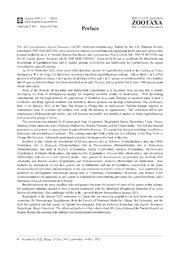Table Of ContentZootaxa 3586: 6–7 (2012) ISSN 1175-5326 (print edition)
www.mapress.com/zootaxa/ ZOOTAXA
Copyright © 2012 · Magnolia Press Preface ISSN1175-5334(online edition)
The All Cypriniformes Species Inventory (ACSII; www.cypriniformes.org), funded by the U.S. National Science
Foundation (NSF DEB 1022720), was conceived as a means of continuing and capitalizing on the successes of two other
projects funded by the U.S. National Science Foundation, the Cypriniformes Tree of Life (CToL: NSF EF-0431326), and
the All Catfish Species Inventory (ACSI: NSF DEB–0315963). Goals of ACSII are to accelerate the discoveries and
descriptions of cypriniform taxa, and to explore patterns of evolution and biodiversity in Cypriniformes, the largest
monophyletic order of craniates.
As of 16 November 2012, there were 4,045 described species of Cypriniformes listed in the Catalog of Fishes
(Eschmeyer, W.N. & Fong, J.D. (Eds) http://research.calacademy.org/ichthyology/catalog). This is about 1 in 3 (33%)
species of all freshwater fishes, 1 in 8 species of all fishes (13%), and 1 in 17 species of vertebrates (6%). Five hundred
and 25 species of cypriniforms have been described in the past 10 years, and we predict that at least 1,000 species await
formal description.
Most of the diversity of described and undescribed cypriniforms is in Southeast Asia, an area that is rapidly
developing the kind of infrastructure needed for sustained scientific studies of biodiversity. This developing
infrastructure and the large diversity of cypriniforms in Southeast Asia made Thailand an excellent place to host a
conference and bring together scientists and students to discuss projects and develop collaborations. The conference,
held 13–16 January, 2012, at the Suan Bua Resort in Chiang Mai in northwestern Thailand brought together an
international team of scientists and students who study the diversity of cypriniforms. The conference led to new
international collaborations and studies, and will increase the number and breadth of studies on Asian cypriniforms as
well as on other groups of fishes.
The conference was attended by 45 participants from 13 countries: Bangladesh, Brunei Darussalam, China, France,
Germany, India, Indonesia, Laos, Malaysia, Philippines, Taiwan, Thailand, and the United States. The first day featured
presentations and posters on topics related to cypriniform biodiversity. The second day featured workshops on collection
techniques and morphological analyses. The meeting concluded with a field trip to a tributary of the Ping River in
Chiang Mai Province. Afterwards, participants enjoyed a barbeque on the bank of the river.
Included in this volume are descriptions of 22 new species, five in Schistura (Nemacheilidae), three in Cobitis
(Cobitidae), two in Homatula (Nemacheilidae), two in Physoschistura (Nemacheilidae), two in Triplophysa
(Nemacheilidae), one each in Rectoris (Cyprinidae), Metzia (Cyprinidae), Barilius (Cyprinidae), Thryssocypris
(Cyprinidae), Barbatula (Balitoridae), Microphysogobio (Cyprinidae), Traccatichthys (Balitoridae), and Erromyzon
(Balitoridae), and one in a new cyprinid genus. Two species of Acrossocheilus (Cyprinidae) are removed from
synonymy, and Barilius ornatus (Cyprinidae) and Homalopteroides modestus (Balitoridae) are redescribed. Also
included are descriptions of two new genera, one in Balitoridae and one in Cyprinidae, resurrection of the genus
Anematichthys (Cyprinidae), and descriptions of six new subspecies of Cobitis striata (Cobitidae). New hypotheses are
presented for phylogenetic relationships among taxa in Cyprininae, Catostomidae, Homatula, and western North
American minnows (Cyprinidae), as are a paper on standardized measurements and counts for cypriniform fishes, and a
discussion of sexual dimorphism in Schistura.
Besides enjoying the many excellent talks and posters that were the subjects of many of the papers in this volume,
the conference attendees decided to have a second conference, with the added goal of exploring formation of an Asian
Society of Ichthyology. That conference will be at the Universiti Brunei Darussalam in January 2013.
Participants in the January 2012 conference in Chiang Mai are extremely grateful to our local hosts, the meeting
moderator, Dr. Weerapongse Tangjitjaroen, from the Faculty of Veterinary Medicine, Chiang Mai University, and the
field trip organizer and fish expert, Dr. Apinun Suvarnaraksha, from the Fisheries Technology and Aquatic Resources
Department, Maejo University. The editors and authors of this volume thank Ms. Jesse Grosso of the Florida Museum of
Natural History for assisting with editorial and organizational responsibilities.
6 Accepted by Z.Q. Zhang: 21 Nov. 2012; published: 14 Dec. 2012
Participants at the All Cypriniformes Species Inventory International Conference in Chiang Mai, Thailand, 14 January 2012. Photo by
Zachary S. Randall.
JONATHAN W. ARMBRUSTER1, LAWRENCE M. PAGE2 & RICHARD L. MAYDEN3
1Department of Biological Sciences, Auburn University,
Auburn, AL 36849, USA; E-mail: [email protected].
2 Florida Museum of Natural History, Gainesville, FL
32611-7800, USA; E-mail: [email protected].
3 Department of Biology, Saint Louis University, St. Louis,
Missouri 63103-2010, USA; E-mail: [email protected].
PREFACE Zootaxa 3586 © 2012 Magnolia Press · 7

